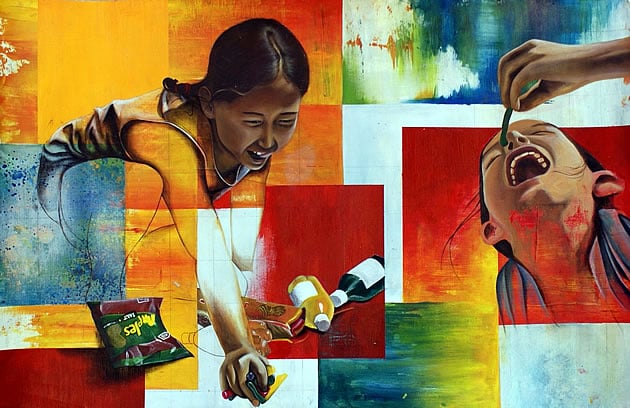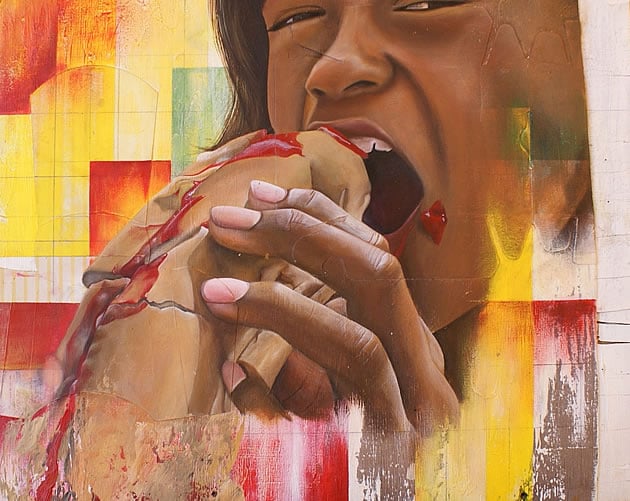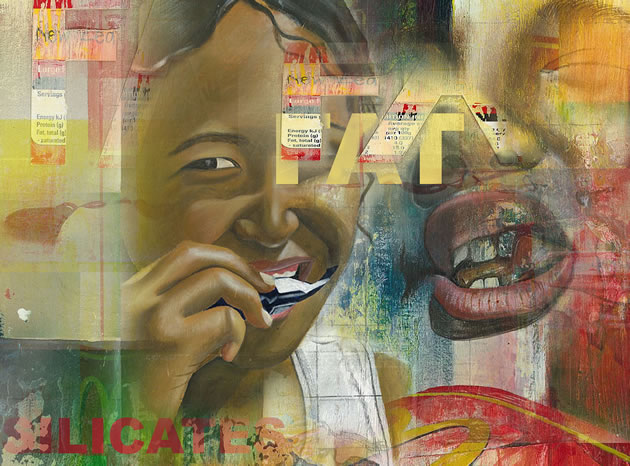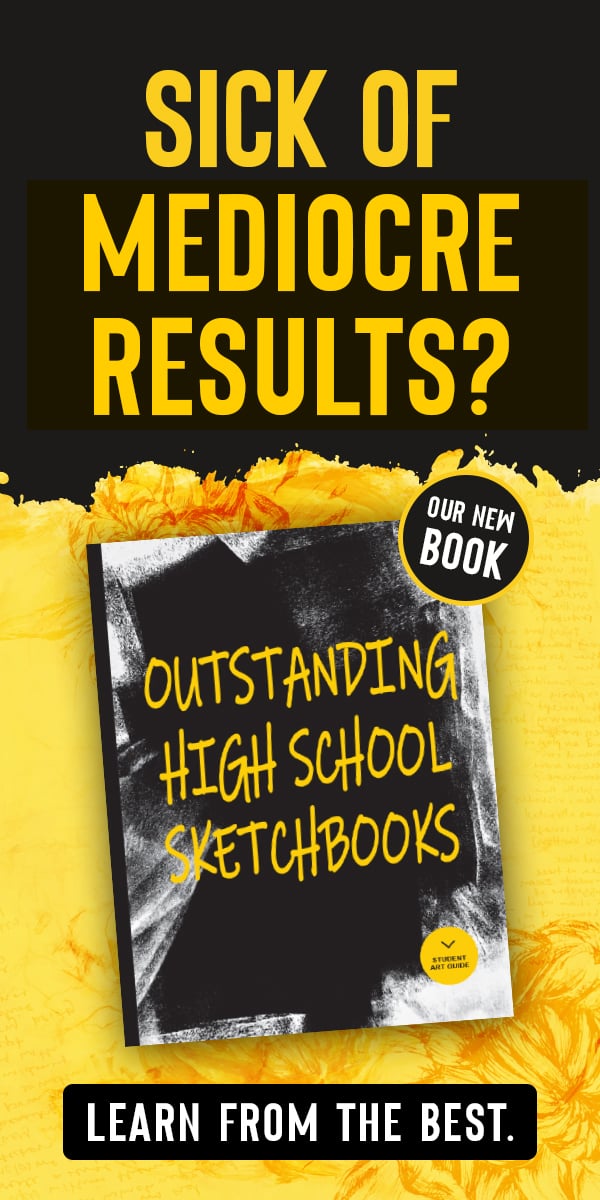Last Updated on December 14, 2024
This outstanding A Level Art project (A2 Painting Coursework, CIE 9704) was completed by Nikau Hindin in 2009, while studying at ACG Parnell College, Auckland, New Zealand. Nikau achieved a final A Level Art result of 98%.
Some of Nikau’s sketchbook pages are included in our new book: Outstanding High School Sketchbooks. This book has high-resolution images so that fine details and annotation are clear, making it an excellent resource for students and schools. Learn more!

Nikau began her A2 Painting Coursework by selecting the topic of junk food, focusing in particular on the excessive consumption of junk food by young people and the health risks that are linked to the consumption of additive-laden, calorie-rich deceptive food products.
Nikau’s initial sketchbook pages (visible in the video at the bottom of this post) are filled with notes and drawings exploring this theme. These include mixed media drawings of junk food items and children as well as an analysis of the visual potential of her theme. Here, Nikau clarified her ideas and established the ‘starting point’ of her project.
Following this, Nikau analysed the artwork of Janet Fish. Nikau was drawn to her paintings of bright, reflective surfaces (something that would be particularly helpful when painting glossy, seductive junk food packaging) and for her ability to create busy, vibrant works that are successful, despite an overload of sensory information. Nikau completed diagrammatic sketches of compositional structure and imitated parts of paintings by Janet Fish, as in the sketchbook page shown above (note that copying parts of an artwork is often all that is needed for a student to gain an understanding of technique…slavishly copying an entire work wastes precious time; note also the use of ‘I’ within the text and the inclusion of personal viewpoints and opinions, linking of comments to her own project – this reassures the examiner that the writing is the student’s own and is not simply copied from a textbook).

With Janet Fish as inspiration, Nikau set up a picnic in a local park, providing a group of young children from her local primary school with junk food such as hamburgers, hot dogs, chips and lollies. Nikau then documented these children as they gorged themselves, taking hundreds of photographs (additional photos were taken throughout the year, as required). A selection of these were analysed in her sketchbook, discussed in terms of their visual potential and how they might lead to paintings that successfully communicate ideas.

The works on Nikau’s first A1 preparatory sheet are observational drawings and paintings of this picnic scene, giving Nikau ample opportunity to demonstrate her outstanding ability to accurately render shape, proportion and form. Extremely detailed, these images provided a wealth of visual material which Nikau is able to explore within her project. Of particular importance are the reaching hands, which support the idea of hunger, desire and the addictive ‘needing’ that accompanies the consumption of junk food; the expression of joy on the children’s faces as they eat, unaware of the health afflictions that may befall them later; the sharp, clear, enticing images of junk food (with attention given, for example, to the shine on the ketchup snaking across the hot dog) and the sense of distance and depth that is achieved in the images due to the use of foreground / background and overlapping of forms. These initial drawings and paintings were completed with the aid of a grid to ensure a very high level of realism. As the A1 sheet progresses, the grid and pencil sketch lines take on greater importance, in the style of portraits by artist Raymond Ching, who, at times, leaves pencil lines visible in his paintings, with tone applied only in certain areas of the work. This balance of ‘complete’ and ‘incomplete’ areas, allows Nikau to create emphasis within the painting, as well as providing visual relief (a break for the eyes) in the busy, detailed works.

The third artist that influenced Nikau’s A2 Art Coursework project was Kelcy Taratoa. He was an important artist, as he was the one that Nikau based her Personal Study on. Nikau visited and interviewed him in person, and was able to see many of his critically acclaimed artworks in the flesh. After analysing his artwork within her sketchbook, Nikau created composition studies that were a combination of hand cut and glued photographs (see the sketchbook page above). She drew onto these and painted over parts, blocking out areas and playing with scale in the style of Kelcy Taratoa. Some of these were scanned and then digitally manipulated further.


Nikau continued to develop her work, learning from artist model Bill Barminski, who was probably the most influential artist model in her project. This led Nikau to embrace space in her work, as well as to extensively explore surface texture. Bill Barminski paints on peeling wooden surfaces; Nikau began to paint over disassembled fast food packages, with the cardboard shapes and text upon them remaining visible through layers of paint. Much of the text on the packages contains lists of artificial ingredients; these words became integral to her compositions. Nikau smears paint over realistic figures, obscuring children’s eyes, as if to indicate that they are blind to the health risks that are linked to what they are eating.

As her work develops, Nikau experiments with stencils and cardboard cut-outs, mimicking the text on packages, enlarging ingredients and flavouring codes, as well as writing almost invisible words such as FAT in the background layers (text is also an integral component of many of Bill Barminski’s works). Many of these words are only visible when the paintings are viewed closely.










When viewing Nikau’s A Level Art project you are immediately struck by the joyful images of children eating…however closer examination of the work brings a slow unease and eventual horror as you see the names of artificial additives and ingredients leaching through the painting surface. Conveying a message cleverly, while retaining absolute attention to the production of aesthetically pleasing images: an excellent A Level Art project.
The following video showcases Nikau’s A2 Coursework project in its entirety:
If you enjoyed this article, you may also be interested in viewing Nikau’s AS Art Coursework and AS Controlled Test.


